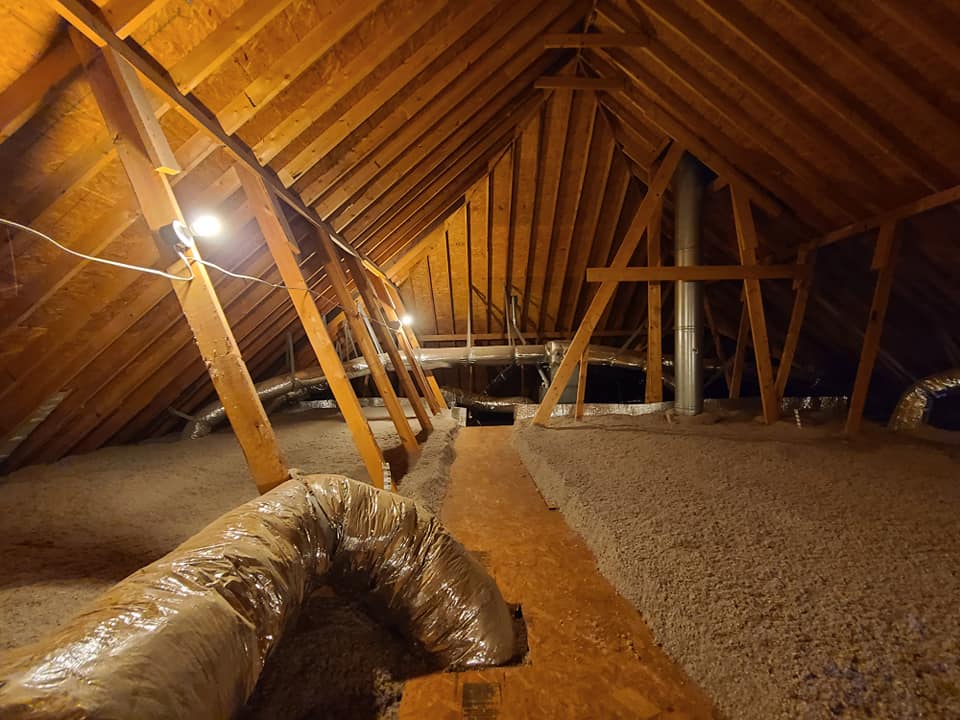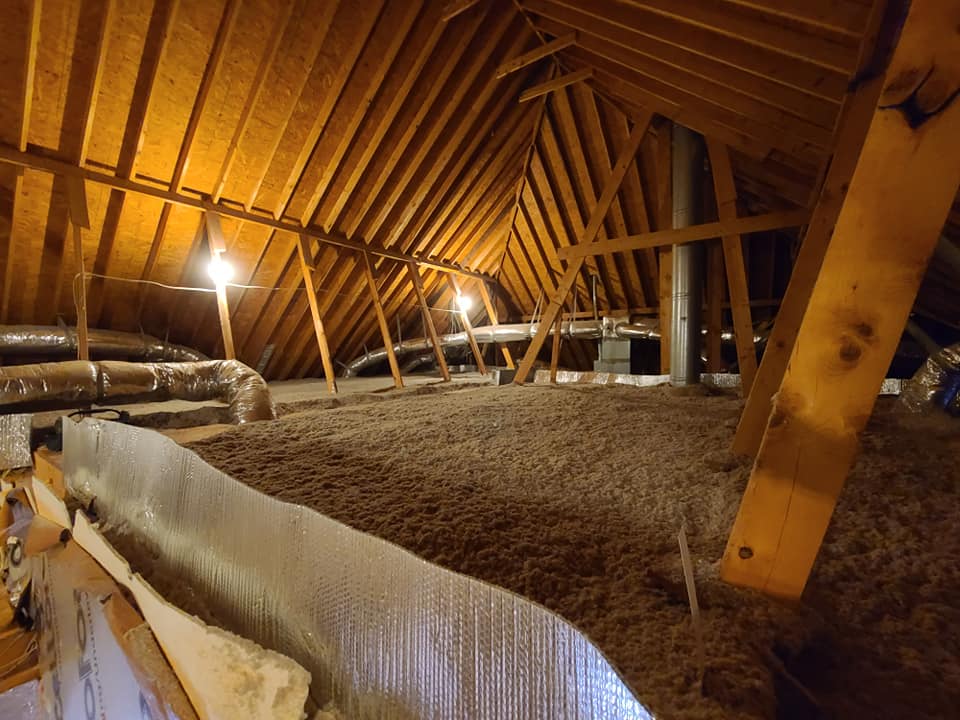With most everything in life, there are tradeoffs. If you want a beach house, there are the hurricanes to deal with. If you want a mountain home, there is the snow and ice to deal with.
As humans, we adapt and overcome; innovate. As cellulose insulation has become more popular over the years, the cellulose manufacturers have addressed negative issues with their product. Here’s a link to the manufacturers association if you are one to do your own research: https://www.cellulose.org/
I upgraded my first attic, using cellulose insulation, in 1998. For over 23 years I’ve been a big fan of cellulose, and remain an obvious raving fan of this wonderful, safe insulation product.
But not everyone shares my enthusiasm.

Here is a short list of the most common objections, issues, and problems that I hear from homeowners and my competitors, as we discuss cellulose insulation. These are in no particular order, except #1 is the most common issue that I hear.
- Cellulose insulation is dusty.
- Cellulose insulation is heavy, and compacts any underlying insulation.
- Because cellulose insulation is paper, it absorbs moisture when it rains, and in areas of high humidity.
- Cellulose insulation degrades over time and has to be replaced.
- Cellulose insulation promotes the growth of mold & mildew in your attic.
Let’s take these one-at-a-time:
1. Cellulose insulation is dusty
Can installing cellulose attic insulation be dusty? When cellulose insulation is installed without stabilizing with water, it will be dusty. The cellulose product we install is Applegate Bora Spray cellulose, and as attic insulation is meant to be stabilized with water. A dust-free installation is really easy… we attach a garden hose to your house spigot, and attach the other end of the hose to our rig. We carefully measure 1 gallon of water to approximately every 60 pounds of cellulose. The cellulose is conditioned with a high-pressure spray of water as the insulation travels through our 4” blowing hose.
Stabilizing cellulose insulation with water benefits our homeowners:
A. No dust in the attic! Your installation is dust free.
B. The water activates the wheat starch in cellulose. The wheat starch is a natural adhesive that binds the cellulose fibers together into a monolithic, high-density insulation. This is why cellulose attic insulation helps air-seal your attic! It dramatically limits convective heat loss. You win with improved indoor air quality, and you’ve dramatically limited the uncontrolled air infiltration trespassing into your home from the attic!
What happens to that water? Because your attic is vented, with about 2 sunny days, that small amount of moisture has evaporated to the atmosphere.

2. Cellulose insulation is heavy, loses R-value from settling, and compacts any underlying insulation.
First, let me say that all loose-fill insulation products settle over time.
Let me also say that cellulose insulation, by law, has to be sold and installed at the “settled density”. Meaning, the coverage charts account for settling while calculating how much insulation to install to achieve any given R-Value.
Often we install several inches of cellulose insulation on top of a pre-existing fiberglass or rockwool insulation. The concern is that the underlying insulation will be compacted somewhat by the heavier cellulose insulation.
That is a legitimate concern, and why it’s always important to factor that small loss in R-Value into your calculation for the expected overall R-Value of your insulation upgrade.
Keep in mind though, that if the underlying insulation is fiberglass, it actually loses R Value during cold winter temperatures through a phenomenon called “Convective Heat Loss”. Studies at Oak Ridge National Laboratory showed loss of nearly 15% of R-value at 20 degrees F. At 18 degrees F below zero the insulation had only about 60% of its nominal R-value. At least one northern state (Minnesota) has required fiberglass producers to change coverage charts to reflect this cold temperature R-value loss. A layer of cellulose on top of the fiber glass has been found to be effective at controlling convective heat loss.
Here at Bird Family Insulation we’ve always practiced rounding up our insulation coverage to the next whole number. For instance, if R-30 is 8.94”, we round up to 9” on our rulers. Also, the manufacturers account for settling of cellulose in the coverage chart. Using R-30, we’re told to install 8.9”, for a settled depth of 8.5”… so we’re initially over-installing ½” of cellulose.
Bottom line: if you’re concerned about cellulose attic insulation compacting your fiberglass insulation, ask your cellulose contractor to account for that compaction in their calculation of final R-Value, and I also suggest that you ask how many bags (of cellulose insulation) does he intend to install. On job day, confirm the bag count with the installer.
3. Because cellulose insulation is paper, it absorbs moisture when it rains, and in areas of high humidity.
I’ve done my research, and not found much information on this. So I don’t think it’s much of an issue. I’ve got over 20 years of experience installing over 4 million pounds of cellulose in the southeast market, and it’s never been an issue for our clients. We’re very active in the government and utility-sponsored energy-saving programs, and to this day we’re applauded for installing cellulose insulation. Here’s what I found on www.cellulose.org… the official Cellulose Manufacturers Association website:
No insulation “attracts” moisture, but various materials exhibit different moisture handling characteristics. Cellulose insulation is a “storage layer” in an assembly. This means it can safely hold moisture that might otherwise move into more vulnerable parts of the assembly and still maintain its thermal resistance. Exfiltration of moisture-laden air into walls and ceilings is the major moisture transfer mechanism. The low air permeability of cellulose all but eliminates this means of moisture movement.
Remember, your Applegate Bora Spray cellulose insulation is over 11% Borate by content. Organisms like mold, mildew, and insects cannot survive when in contact with boric acid. Bird Family Insulation only installs Applegate Bora Spray.
One last thought: we’re instructed by the manufacturer to stabilize the cellulose insulation with water as we install. That small amount of moisture evaporates within 48 hours of sunny weather. If a little moisture was problematic, we wouldn’t be instructed to use it during our installation!

4. Cellulose insulation degrades over time and has to be replaced.
As I researched this on the internet, I found no mention of degradation by the cellulose manufacturers. In fact, during my last 20+ years, both Applegate and Cocoon (U.S. Green Fiber) cellulose came with a limited warranty that guaranteed the R Value for the lifetime of the structure. Currently (2021), Applegate continues to guarantee our cellulose insulation to perform at the installed R Value for the lifetime of the structure, when installed properly, etc.
“Lifetime of structure” sounds like a long time to me!
5. Cellulose insulation promotes the growth of mold & mildew in your attic.
This is simply not true. Cellulose Insulation is no more subject to mold contamination than any other building material. Your home is constructed with wood (cellulose) throughout! Published studies indicate that the hygroscopic nature of cellulose insulation results in superior moisture handling characteristics.
Remember, your Applegate Bora Spray cellulose insulation is over 11% Borate by content. Organisms and insects cannot survive when in contact with boric acid. Bird Family Insulation only installs Applegate Bora Spray.
Cellulose attic insulation is a healthy, long-lasting, wonderful insulation product. Is it ideal for your needs? You should do your own research and make a wise, informed decision. If you need more information, I’m here to help!
Article written by Bob Bird
Bird Family Insulation





